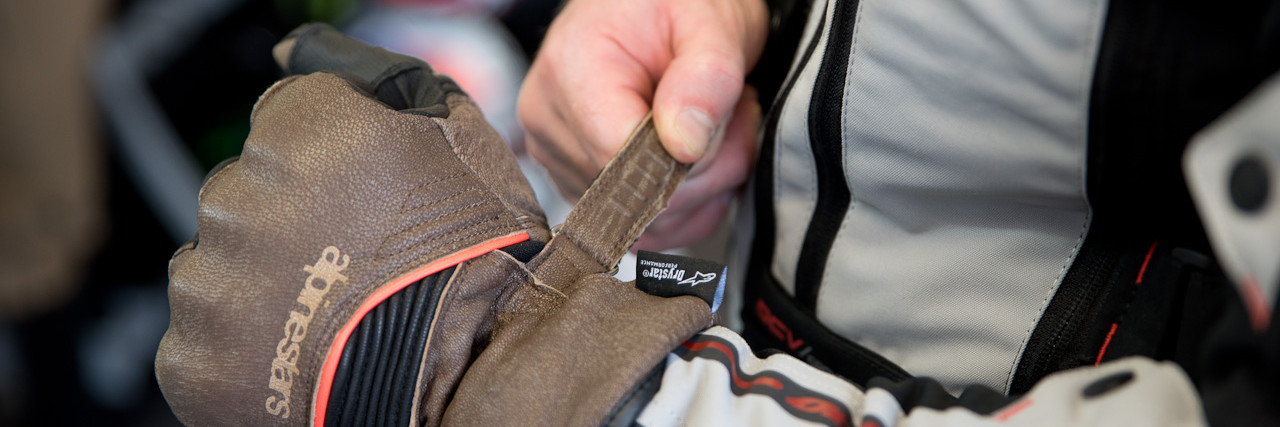Looking after your gear
Money spent on good gear is never wasted, but you’ve got to look after it. Care for your gear and it will continue to look after you.
Helmet and visor
A new helmet will last three to five years, depending on use. After that, the interior cushioning and structure will start to break down under attack from the sweat and oils from your scalp. Meanwhile, sunlight and heat cycles can begin to degrade the strength of the outer shell, reducing its protective performance.
If you buy a used helmet you won’t know if it has been dropped. When a helmet has fallen onto a hard surface from any real height, even out of your hand, the impact can compromise the integrity of the shell. You can’t tell by looking at it. The tough truth about helmets is they are designed to work once, then be thrown away. Avoid buying a used helmet; always replace a dropped one.
How to keep your lid in top condition
- Never sit on your helmet, put it under pressure or distort the shell.
- If you drop it, or it makes ground contact in a crash, bin it and buy a new one.
- Don’t shove your gloves inside. The sweat, road dirt and leather compounds attack the inner cushioning and liner.
- Never paint your crash helmet. The volatile compounds in some paints can attack the outer shell - polycarbonate is especially vulnerable. If you want a custom job, give it to a professional who will use the right paint formula.
- Clean the outer shell with a soft micro-fibre cloth and car shampoo. Never apply anything abrasive and avoid dishwashing liquid, which contains saline and rots metal, e.g. the fastening. Also avoid anything corrosive such as bleach or cleaning compounds.
- Clean the visor frequently with a soft, wet sponge or micro-fibre cloth. You can use dishwashing liquid to clean the visor but try not to spill it over the rest of the lid. It’s best to take it off anyway, to clean both sides.
- To remove baked-on flies on your lid or visor, apply a clean, soaking-wet cotton cloth or towel. Leave it for an hour or two before cleaning it.
- Dry your washed visor with a clean micro-fibre towel. Avoid scratching.
- Once a month, take out all removable parts of the cushioned liner and hand wash in cold water. Rinse thoroughly and allow to dry naturally out of direct sunlight.
- Replace any parts of the cushioned liner that have compressed or have worn through the plush nylon covering.
- Check the neck strap for fraying once a week. At the first sign, get a new helmet.
- Check the D-rings for any roughness or cracks. Helmets with seat-belt type fasteners have been off the market for some time now, so if you have one it’s time to consider a replacement.
- Check the visor mounting plate screws for fastness every week.
Transporting helmets
Never ride with your arm shoved through the aperture or fastened strap of a spare helmet. It affects your control, and can cause severe injury in an accident. The same goes for carrying one in a normal rucksack. Also, don’t ride with it strapped to the helmet hook. You’ll likely damage the helmet and your bike. Use the hook only when parked.
The only ways to carry a helmet are:
- in a purpose-designed backpack - with back protector
- a big tankbag or tailpack
- inside a locked topbox or pannier.
Prevent damage by wrapping your lid with soft cloth or bubble wrap.
Storing helmets
Store helmets collar side down on a shelf or use a helmet bag. Don’t use a mannequin head, it will compress the interior padding. Never hang them by the chin strap.
Jackets, pants or one-piece
Every garment needs an occasional check over for loose threads or fasteners. There are different ways to clean and maintain different fabrics. Start by dusting off any loose material with a soft brush.

Leather
- Clean using a soft sponge and specialist leather cleaner, or a diluted solution of car shampoo or sugar soap.
- Allow damp leather to dry naturally, out of the sun.
- Feed and clean with dubbing or leather conditioner.
Removable mesh and thermal linings may be washable
Check:
- care instruction label
- armour inserts after any crash.
Hard foam armour
On hard foam armour damage will show up as crushing or cracks and need replacement. They’re inexpensive or you could go for an upgrade to viscoelastic type armour that is generally reusable.
Textiles/cordura and waterproofs
- Using a soft sponge, clean with a purpose-made textile cleaner, car shampoo or sugar soap.
- Use a nail brush on ingrained dirt.
- Wipe residue off with a damp sponge or soft cloth and dry on clothes line. Never use a dryer.
- Apply appropriate waterproofing monthly.
- Check care label for removable mesh and thermal linings.
- Check armour inserts after any crash.
Kevlar jeans
- Check care instructions for washing. If in doubt, cool hand wash and line dry inside out.
- If torn after a crash or the material stars to thin, get rid of it.
Washing also degrades the Kevlar. The useful life is around 25 to 30 washes, then you’ll need to replace the jeans.
Transporting clothing
Transport clothing inside a proper motorcycle gear bag. A normal rucksack is fine for soft clothing but be wary of armour. It can cause serious injury if you land on your back.
Strapping clothing to the pillion seat may be more comfortable, but keep the load small and wrap the clothing securely. If a sleeve or leg comes loose it could catch in the chain and lock the rear wheel. Use cling wrap or a strong plastic bag big enough to fold under itself. Bungy the package down tightly so it cannot slip or slide in any direction.
Storing clothing
Store clothing in a warm, dry, well-ventilated place, not a damp shed or garage. Clothing can be stored flat but a hanger with large, round shoulder support is best for jackets and one piece suits. For bottoms, use a waistband clip hanger. Kevlar-lined denim jeans are fine on a normal hanger.
Gloves
- Wipe clean using a damp sponge and a specialist leather cleaner, or diluted car shampoo or sugar soap.
- Dry wet leather gloves by stuffing with newspaper and keep out of sunlight. Don’t apply any heat.
- Feed the cleaned gloves with dubbing or leather conditioner.
- Clean winter or waterproof textile gloves using a textile clothing cleaner, diluted car shampoo or sugar soap. Dry naturally and reapply waterproofing compound.
- Check all seams, fastenings and armour.
- Dust off any dirt.
If anything is loose, worn or missing, it’s time for a new pair. Leather gloves are hard to keep clean, but it’s worth doing.
Boots
- Dust off and clean just like you would gloves, then apply a little leather or fabric care.
- Check the soles for wear, fastenings for security and that any external armour is screwed on tight.
Transporting gloves and boots
For transporting gloves and boots proper motorcycle luggage is always best. Gloves may just fit under the seat, but make sure they won’t interfere with electrical connections or the seat locking mechanism.
At a push, you can bungy boots to the pillion seat. Just make sure they’re done up and cannot move around.
Storing boots and gloves
Store boots in a dry place, not in a damp shed or garage. The main issue with gloves is to avoid shoving them in your helmet because they’ll contaminate and degrade the inner cushioning and liner. Also, if you’re putting leather gloves away for any length of time give them a good feed of dubbing or conditioner.
Remember – wear all the gear
A crash can happen at any time, often when you least expect it. So, make sure you wear 'All The Gear All The Time' – ATGATT.




